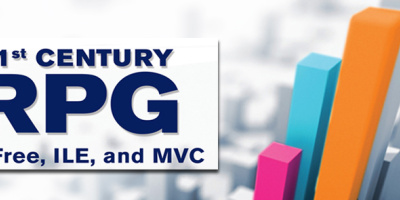The debate over whether to code new RPG programs in the free-format style has just about ended. Most agree that this style is preferable, in one way or another. With this shift in coding style comes a not-so-fun shift in work habits.
The free-format style of RPG has many fewer operations than its fixed-format sibling. At V5R3, there are 59 free-format opcodes and 112 fixed-format ops. Many of the commonly used opcodes of the "fixed" world are just not there in free-format. Some of these we probably won't miss very much, such as the four zone moves (MHHZO, etc.), the math ops (ADD, SUB, MULT, DIV, and MVR), the numeric moves (Z-ADD and Z-SUB), and the indicator set duo (SETON and SETOFF).
Some programmers will agonize over the loss of the "compare and branch" group (CABxx) and GOTO/TAG. I don't mean to sound critical, but programs using these operations are not well-structured. These opcodes were needed in the era that preceded structured loop operations. Perhaps you began coding when CABxx and GOTO were the only way to conditionally loop, but it's time to overcome this old habit. In free-format, you use DOx and FOR groups with loop interrupters LEAVE and ITER.
Many fixed-format opcodes have become built-in functions (BIFs). The BIF method becomes the only way to do the work in free-format. The many BIF alternatives perform the same functions as the old opcodes did. The following are a couple of examples. The first uses table lookup:
C TEST LOOKUP TAB1 TAB2 70
C IF *IN70
C ----
The equivalent in free-format style would be the following:
If %tlookup(Test:Tab1:Tab2);
----
Here's another example using substringing:
The equivalent in free-format style would be this:
/free
First = %subst(Name:5:4);
To overcome the habit of using these familiar opcodes, some "school" time is needed to learn the BIFs that replace opcodes. Most are very straightforward and easy to learn. Since the BIFs can be used in an expression, you can practice using them in fixed-format by placing them in the extended factor 2 area and using an Eval opcode. This may be a good transition method for you before going exclusively to free-format.
By far, the most common habit—one that we must overcome—is the use of the MOVEx operations. These opcodes are used extensively in fixed-format RPG but are not available in free-format. I won't try to oversimplify the task of finding a best alternative for these operations. Here are a few suggestions, however.
The MOVE operation can do many different things, depending on the factors used. IBM calls this a "loaded" operation. The compiler must determine what function to perform based on the data types of the factors, lengths of the factors, and options specified in factor 1. Since there is no MOVE opcode in free-format, we must decide what alternative is appropriate for the function needed. To convert a field from character to numeric, we can use the %dec or the %int BIF. To convert a field from numeric to character, we can use the %char or the %editc (with 'x' code) BIF. To move a character field to another character field with right justification, the EVALR opcode may work. To move characters to a receiving field that is longer than the source field (and padding is not desired), the %subst or the %replace BIF can do the job (albeit more parameters and keystrokes are needed).
Here's an example:
D Long S 6 Inz('WWLLYY')
C Move Short Long
* Long is now 'WWLLAA'
Here's the equivalent in free-format:
Long=%replace(Short:Long:%len(Long)-
%len(Short)+1);
Another method uses two statements but is a little less cumbersome:
EvalR Long = Long + Short;
The MOVEL operation isn't quite as hard to handle. Mostly, the EVAL operation or simply an assignment statement works OK. For character moves that have a receiving field longer than the source field, the %replace BIF can easily do the job. Here's an example:
D Long S 6 Inz('WWLLYY')
C MoveL Short Long
* Long is now 'AALLYY'
This is the free-format equivalent:
Long = %replace(Short:Long);
The MOVEA operation has been addressed in a prior technical tip, but any way you look at it, there is work to do in analyzing the task (previously done using MoveA) and deciding on a best alternative.
We are creatures of habit, and free-format RPG has forced us to move out of our comfort zone. The result of shaking these old habits and acquiring new ones is better, more readable programs.
Jim Martin, the author of Free-Format RPG IV, is a corporate technical instructor at Jack Henry & Associates in Monett, Missouri. He is a veteran of RPG programming, beginning in 1967 with a position at IBM as a systems engineer and later as a staff programmer at the Rochester systems programming lab. He is a speaker at COMMON and local midrange user group meetings and conferences. For eight years, he was at Lakeview Technology as an AS/400 and RPG instructor. He can be reached by email at


























 More than ever, there is a demand for IT to deliver innovation. Your IBM i has been an essential part of your business operations for years. However, your organization may struggle to maintain the current system and implement new projects. The thousands of customers we've worked with and surveyed state that expectations regarding the digital footprint and vision of the company are not aligned with the current IT environment.
More than ever, there is a demand for IT to deliver innovation. Your IBM i has been an essential part of your business operations for years. However, your organization may struggle to maintain the current system and implement new projects. The thousands of customers we've worked with and surveyed state that expectations regarding the digital footprint and vision of the company are not aligned with the current IT environment. TRY the one package that solves all your document design and printing challenges on all your platforms. Produce bar code labels, electronic forms, ad hoc reports, and RFID tags – without programming! MarkMagic is the only document design and print solution that combines report writing, WYSIWYG label and forms design, and conditional printing in one integrated product. Make sure your data survives when catastrophe hits. Request your trial now! Request Now.
TRY the one package that solves all your document design and printing challenges on all your platforms. Produce bar code labels, electronic forms, ad hoc reports, and RFID tags – without programming! MarkMagic is the only document design and print solution that combines report writing, WYSIWYG label and forms design, and conditional printing in one integrated product. Make sure your data survives when catastrophe hits. Request your trial now! Request Now. Forms of ransomware has been around for over 30 years, and with more and more organizations suffering attacks each year, it continues to endure. What has made ransomware such a durable threat and what is the best way to combat it? In order to prevent ransomware, organizations must first understand how it works.
Forms of ransomware has been around for over 30 years, and with more and more organizations suffering attacks each year, it continues to endure. What has made ransomware such a durable threat and what is the best way to combat it? In order to prevent ransomware, organizations must first understand how it works. Disaster protection is vital to every business. Yet, it often consists of patched together procedures that are prone to error. From automatic backups to data encryption to media management, Robot automates the routine (yet often complex) tasks of iSeries backup and recovery, saving you time and money and making the process safer and more reliable. Automate your backups with the Robot Backup and Recovery Solution. Key features include:
Disaster protection is vital to every business. Yet, it often consists of patched together procedures that are prone to error. From automatic backups to data encryption to media management, Robot automates the routine (yet often complex) tasks of iSeries backup and recovery, saving you time and money and making the process safer and more reliable. Automate your backups with the Robot Backup and Recovery Solution. Key features include: Business users want new applications now. Market and regulatory pressures require faster application updates and delivery into production. Your IBM i developers may be approaching retirement, and you see no sure way to fill their positions with experienced developers. In addition, you may be caught between maintaining your existing applications and the uncertainty of moving to something new.
Business users want new applications now. Market and regulatory pressures require faster application updates and delivery into production. Your IBM i developers may be approaching retirement, and you see no sure way to fill their positions with experienced developers. In addition, you may be caught between maintaining your existing applications and the uncertainty of moving to something new. IT managers hoping to find new IBM i talent are discovering that the pool of experienced RPG programmers and operators or administrators with intimate knowledge of the operating system and the applications that run on it is small. This begs the question: How will you manage the platform that supports such a big part of your business? This guide offers strategies and software suggestions to help you plan IT staffing and resources and smooth the transition after your AS/400 talent retires. Read on to learn:
IT managers hoping to find new IBM i talent are discovering that the pool of experienced RPG programmers and operators or administrators with intimate knowledge of the operating system and the applications that run on it is small. This begs the question: How will you manage the platform that supports such a big part of your business? This guide offers strategies and software suggestions to help you plan IT staffing and resources and smooth the transition after your AS/400 talent retires. Read on to learn:
LATEST COMMENTS
MC Press Online